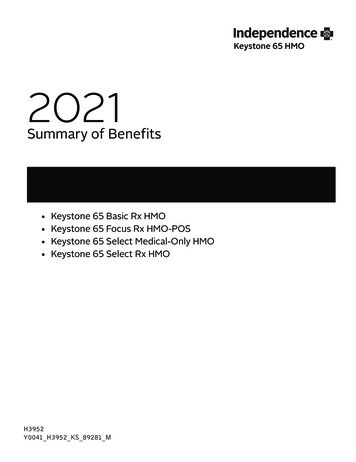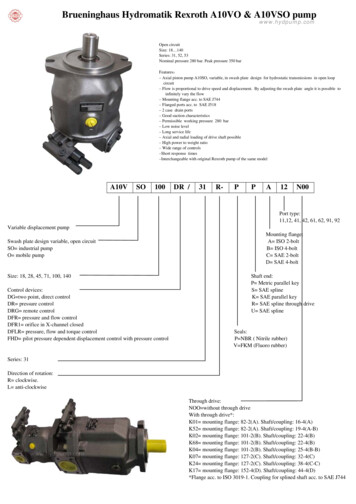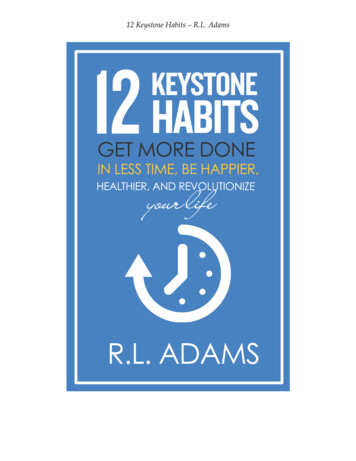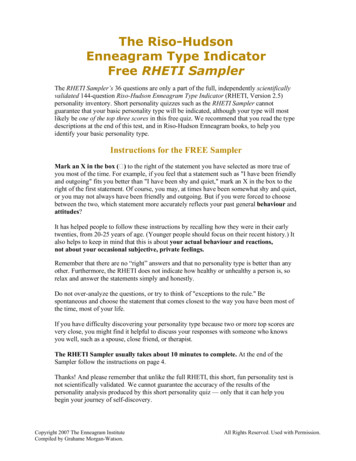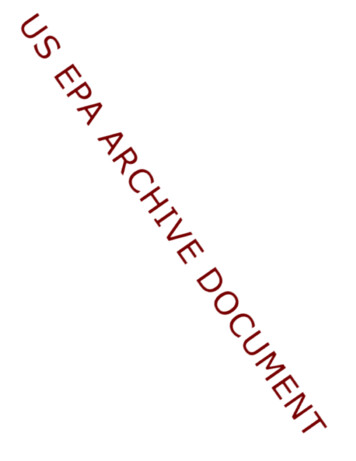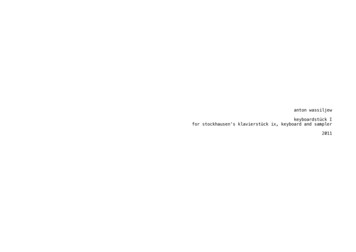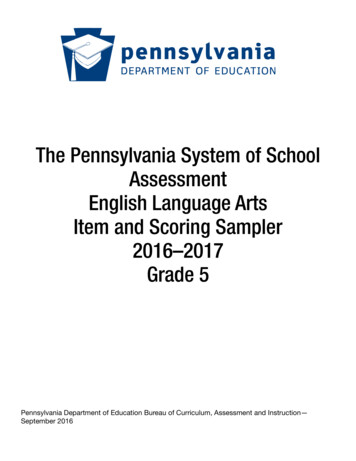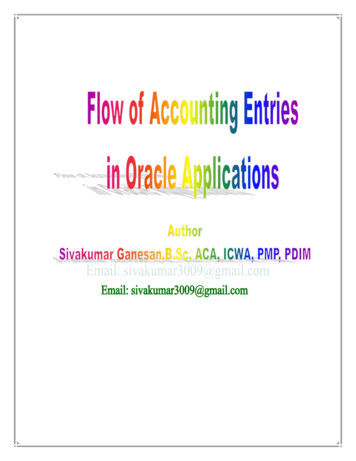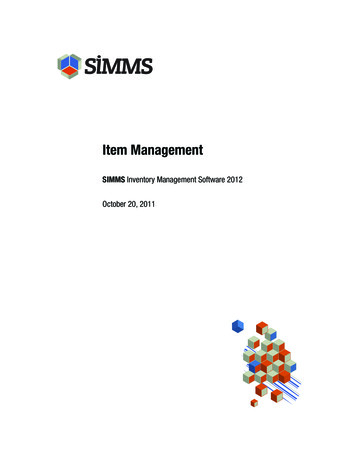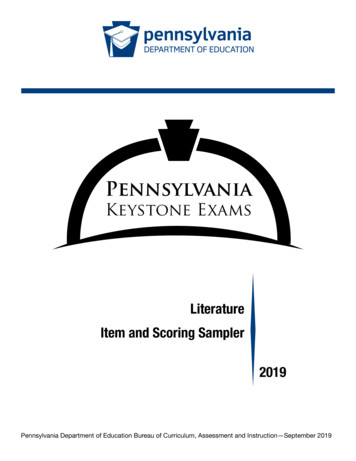
Transcription
PennsylvaniaKeystone ExamsLiteratureItem and Scoring Sampler2019Pennsylvania Department of Education Bureau of Curriculum, Assessment and Instruction—September 2019
TABLE OF CONTENTSINFORMATION ABOUT LITERATUREIntroduction. . . . . . . . . . . . . . . . . . . . . . . . . . . . . . . . . . . . . . . . . . . . . . . . . . . . . . . . . . . . . . . . . . . . . . . . . . . . . . . . . . . . . . . . 1About the Keystone Exams. . . . . . . . . . . . . . . . . . . . . . . . . . . . . . . . . . . . . . . . . . . . . . . . . . . . . . . . . . . . . . . . . . . . . . . . . . 1Alignment . . . . . . . . . . . . . . . . . . . . . . . . . . . . . . . . . . . . . . . . . . . . . . . . . . . . . . . . . . . . . . . . . . . . . . . . . . . . . . . . . . . . . 1Depth of Knowledge. . . . . . . . . . . . . . . . . . . . . . . . . . . . . . . . . . . . . . . . . . . . . . . . . . . . . . . . . . . . . . . . . . . . . . . . . . . 2Exam Format. . . . . . . . . . . . . . . . . . . . . . . . . . . . . . . . . . . . . . . . . . . . . . . . . . . . . . . . . . . . . . . . . . . . . . . . . . . . . . . . . . . 2Item and Scoring Sampler Format. . . . . . . . . . . . . . . . . . . . . . . . . . . . . . . . . . . . . . . . . . . . . . . . . . . . . . . . . . . . . . . . . . . 3Literature Test Directions. . . . . . . . . . . . . . . . . . . . . . . . . . . . . . . . . . . . . . . . . . . . . . . . . . . . . . . . . . . . . . . . . . . . . . . . . . . . 4General Description of Scoring Guidelines for Literature. . . . . . . . . . . . . . . . . . . . . . . . . . . . . . . . . . . . . . . . . . . . . . 5LITERATURE MODULE 1Passage 1. . . . . . . . . . . . . . . . . . . . . . . . . . . . . . . . . . . . . . . . . . . . . . . . . . . . . . . . . . . . . . . . . . . . . . . . . . . . . . . . . . . . . . . . . . . 6Constructed‑Response Item. . . . . . . . . . . . . . . . . . . . . . . . . . . . . . . . . . . . . . . . . . . . . . . . . . . . . . . . . . . . . . . . . . . . . . . 18Item‑Specific Scoring Guideline. . . . . . . . . . . . . . . . . . . . . . . . . . . . . . . . . . . . . . . . . . . . . . . . . . . . . . . . . . . . . . . 19Passage 2. . . . . . . . . . . . . . . . . . . . . . . . . . . . . . . . . . . . . . . . . . . . . . . . . . . . . . . . . . . . . . . . . . . . . . . . . . . . . . . . . . . . . . . . . 24Constructed‑Response Item. . . . . . . . . . . . . . . . . . . . . . . . . . . . . . . . . . . . . . . . . . . . . . . . . . . . . . . . . . . . . . . . . . . . . . . 34Item‑Specific Scoring Guideline. . . . . . . . . . . . . . . . . . . . . . . . . . . . . . . . . . . . . . . . . . . . . . . . . . . . . . . . . . . . . . . 35Literature Module 1—Summary Data. . . . . . . . . . . . . . . . . . . . . . . . . . . . . . . . . . . . . . . . . . . . . . . . . . . . . . . . . . . . . . 40LITERATURE MODULE 2Passage 1. . . . . . . . . . . . . . . . . . . . . . . . . . . . . . . . . . . . . . . . . . . . . . . . . . . . . . . . . . . . . . . . . . . . . . . . . . . . . . . . . . . . . . . . . 42Constructed‑Response Item. . . . . . . . . . . . . . . . . . . . . . . . . . . . . . . . . . . . . . . . . . . . . . . . . . . . . . . . . . . . . . . . . . . . . . . 54Item‑Specific Scoring Guideline. . . . . . . . . . . . . . . . . . . . . . . . . . . . . . . . . . . . . . . . . . . . . . . . . . . . . . . . . . . . . . . 55Passage 2. . . . . . . . . . . . . . . . . . . . . . . . . . . . . . . . . . . . . . . . . . . . . . . . . . . . . . . . . . . . . . . . . . . . . . . . . . . . . . . . . . . . . . . . . 61Constructed‑Response Item. . . . . . . . . . . . . . . . . . . . . . . . . . . . . . . . . . . . . . . . . . . . . . . . . . . . . . . . . . . . . . . . . . . . . . . 72Item‑Specific Scoring Guideline. . . . . . . . . . . . . . . . . . . . . . . . . . . . . . . . . . . . . . . . . . . . . . . . . . . . . . . . . . . . . . . 73Literature Module 2—Summary Data. . . . . . . . . . . . . . . . . . . . . . . . . . . . . . . . . . . . . . . . . . . . . . . . . . . . . . . . . . . . . . 78ACKNOWLEDGEMENTS. . . . . . . . . . . . . . . . . . . . . . . . . . . . . . . . . . . . . . . . . . . . . . . . . . . . . . . . . . . . . . . . . . . . . . . . 79Keystone Literature Item and Scoring Sampler—September 2019ii
INFORMATION ABOUT LITERATUREINTRODUCTIONThe Pennsylvania Department of Education (PDE) provides districts and schools with tools to assist indelivering focused instructional programs aligned to the Pennsylvania Core Standards. These tools includethe standards, assessment anchor documents, Keystone Exams Test Definition, Classroom Diagnostic Tool,Standards Aligned System, and content‑based item and scoring samplers. This 2019 Literature Item andScoring Sampler is a useful tool for Pennsylvania educators in preparing students for the Keystone Exams byproviding samples of test item types and scored student responses. The Item Sampler is not designed to beused as a pretest, a curriculum, or other benchmark for operational testing.This Item and Scoring Sampler contains released operational multiple‑choice and constructed‑responseitems that have appeared on previously administered Keystone Exams. These items will not appear onany future Keystone Exams. Released items provide an idea of the types of items that have appeared onoperational exams and that will appear on future operational Keystone Exams. Each item has been through arigorous review process to ensure alignment with the Assessment Anchors and Eligible Content. This samplerincludes items that measure a variety of Assessment Anchor or Eligible Content statements, but it does notinclude sample items for all Assessment Anchor or Eligible Content statements.The items in this sampler may be used1 as samples of item types that students will encounter in operationaltesting. Classroom teachers may find it beneficial to have students respond to the constructed‑responseitems in this sampler. Educators can then use the sampler as a guide to score the responses eitherindependently or together with colleagues.This Item and Scoring Sampler is available in Braille format. For more information regarding Braille,call (717) 901‑2238.ABOUT THE KEYSTONE EXAMSThe Keystone Exams are end‑of‑course assessments currently designed to assess proficiencies in Algebra I,Biology, and Literature. For detailed information about how the Keystone Exams are being integrated into thePennsylvania graduation requirements, please contact the Pennsylvania Department of Education or visit thePDE website at http://www.education.pa.gov.AlignmentThe Literature Keystone Exam consists of questions grouped into two modules: Module 1—Fiction Literatureand Module 2—Nonfiction Literature. Each module corresponds to specific content aligned to statementsand specifications included in the course‑specific Assessment Anchor documents. The Literature contentincluded in the Keystone Literature multiple‑choice items will align with the Assessment Anchors as definedby the Eligible Content statements. The process skills, directives, and action statements will also specificallyalign with the Assessment Anchors as defined by the Eligible Content statements.The content included in Literature constructed‑response items aligns with content included in the EligibleContent statements. The process skills, directives, and action statements included in the performancedemands of the Literature constructed‑response items align with specifications included in the AssessmentAnchor statements, the Anchor Descriptor statements, and/or the Eligible Content statements. In other words,the verbs or action statements used in the constructed‑response items or stems can come from the EligibleContent, Anchor Descriptor, or Assessment Anchor statements.1The permission to copy and/or use these materials does not extend to commercial purposes.Keystone Literature Item and Scoring Sampler—September 20191
INFORMATION ABOUT LITERATUREDepth of KnowledgeWebb’s Depth of Knowledge (DOK) was created by Dr. Norman Webb of the Wisconsin Center for EducationResearch. Webb’s definition of depth of knowledge is the cognitive expectation demanded by standards,curricular activities, and assessment tasks. Webb’s DOK includes four levels, from the lowest (basic recall)level to the highest (extended thinking) level.Level 1Level 2Depth of KnowledgeRecallBasic Application of Skill/ConceptLevel 3Level 4Strategic ThinkingExtended ThinkingEach Keystone item has been through a rigorous review process and is assigned a DOK level. For additionalinformation about depth of knowledge, please visit the PDE website at e Exams Understanding Depth of Knowledge and Cognitive Complexity.pdf.Exam FormatThe Keystone Exams are delivered in a paper‑and‑pencil format as well as in a computer‑based online format.The multiple‑choice items require students to select the best answer from four possible answer options andrecord their answers in the spaces provided. The correct answer for each multiple-choice item is worth onepoint. The constructed‑response items require students to develop and write (or construct) their responses.There is a single response page in the pencil‑and‑paper and up to 1,000 characters in the online format.Constructed-response items in Literature are scored using item-specific scoring guidelines based on a0‑ to 3‑point scale. Each multiple‑choice item is designed to take about one to one‑and‑a‑half minutes tocomplete. Each constructed-response item is designed to take about 10 minutes to complete. The estimatedtime to respond to a test question is the same for both test formats. During an actual exam administration,students are given additional time as necessary to complete the exam.Keystone Literature Item and Scoring Sampler—September 20192
INFORMATION ABOUT LITERATUREITEM AND SCORING SAMPLER FORMATThis sampler includes the test directions and scoring guidelines that appear in the Keystone Exams. Eachsample multiple‑choice item is followed by a table that includes the alignment, the answer key, the DOK,the percentage2 of students who chose each answer option, and a brief answer option analysis or rationale.Each constructed‑response item is followed by a table that includes the alignment, the DOK, and the meanstudent score. Additionally, each of the included item-specific scoring guidelines is combined with samplestudent responses representing each score point to form a practical, item-specific scoring guide. TheGeneral Description of Scoring Guidelines for Literature used to develop the item-specific scoring guidelinesshould be used if any additional item-specific scoring guidelines are created for use within local instructionalprograms.Example Multiple‑Choice Item Information TableItem InformationAlignmentAnswer KeyDepth of Knowledgep‑value Ap‑value Bp‑value Cp‑value DOption AnnotationsAssigned AAECCorrect answerAssigned DOKPercentage of students who selected this optionPercentage of students who selected this optionPercentage of students who selected this optionPercentage of students who selected this optionBrief answer option analysis or rationaleExample Open‑Ended Item Information TableAlignment2Assigned AAECDepth of KnowledgeAssignedDOKMean ScoreAll p‑value percentages listed in the item information tables have been rounded.Keystone Literature Item and Scoring Sampler—September 20193
INFORMATION ABOUT LITERATURELITERATURE TEST DIRECTIONSDirections:On the following pages of this test booklet are the Keystone Literature Exam passages and questions forModule 1.This module has two passage sets. Each passage set includes a passage, a series of multiple‑choicequestions, and at least one constructed‑response question.Before responding to any exam questions, be sure to carefully read each passage and follow the directionsfor each passage set.There are two types of questions in each module.Multiple‑Choice QuestionsThese questions will ask you to select an answer from among four choices. Read each question, and choose the correct answer. Only one of the answers provided is correct. Record your answer in the Literature answer booklet.Constructed‑Response QuestionsThese questions will require you to write your response. Be sure to read the directions carefully. You cannot receive the highest score for a constructed‑response question withoutfollowing all directions. If the question asks you to do multiple tasks, be sure to complete all tasks. If the question asks you to explain, be sure to explain. If the question asks you toanalyze, describe, or compare, be sure to analyze, describe, or compare. All responses must be written in the appropriate response space in the Literatureanswer booklet. If you use scratch paper to write your draft, be sure to transfer your finalresponse to the Literature answer booklet.If you finish early, you may check your work in Module 1 [or Module 2] only. Do not look ahead at the questions in Module 2 of your exam materials. After you have checked your work, close your exam materials.You may refer to this page at any time during this portion of the exam.Keystone Literature Item and Scoring Sampler—September 20194
INFORMATION ABOUT LITERATUREGENERAL DESCRIPTION OF SCORING GUIDELINES FOR LITERATURE3 Points The response provides a clear, complete, and accurate answer to the task. The response provides relevant and specific information from the passage.2 Points The response provides a partial answer to the task. The response provides limited information from the passage and may include inaccuracies.1 Point The response provides a minimal answer to the task. The response provides little or no information from the passage and may include inaccuracies.OR The response relates minimally to the task.0 Points The response is totally incorrect or irrelevant or contains insufficient information to demonstratecomprehension.Special Categories within zero reported separately:Blank Blank, entirely erased, entirely crossed out, or consists entirely ofwhite spaceRefusal Refusal to respond to the taskOff Task Makes no reference to the item but is not an intentional refusalForeign Language Written entirely in a language other than EnglishIllegible Illegible or incoherentKeystone Literature Item and Scoring Sampler—September 20195
1LITERATUREMODULE 1LITERATURE MODULE 1PASSAGE 1Read the following passage. Then answer questions 1–10.Another Dogby Francis Hopkinson SmithDo not tell me dogs cannot talk. I know better. I saw it all myself. It was at Sterzing, that mostpicturesque of all the Tyrolean villages on the Italian slope of the Brenner, with its long, singlestreet, zigzagged like a straggling path in the snow. On both sides of this street ran arcadessheltering shops, their doorways piled with cheap stuffs, fruit, farm implements, and the like, and atthe far end, it was almost the last house in the town, stood the old inn, where you breakfast. Suchan old, old inn, with swinging sign framed by fantastic iron work. There was a great archway, too,wide and high, with enormous, barn-like doors fronting on this straggling, zigzag street. Under thisa cobble-stone pavement led to the door of the coffee-room and out to the stable beyond.Under this great archway, then, against one of these doors, his big paws just inside the shadowline,—for it was not winter, but a brilliant summer morning, the grass all dusted with powdereddiamonds, the sky a turquoise, the air a joy,—under this archway, I say, sat a big St. Bernard dog,squat on his haunches, his head well up, like a guard. His eyes commanded the approaches downthe road, up the road, and across the street; taking in the passing peddler with the tinware, andthe girl with a basket strapped to her back, her fingers knitting for dear life, not to mention sounimportant an object as myself swinging down the road.He made no objection to my entering, neither did he receive me with any show of welcome.There was no bounding forward, no wagging of the tail, no aimless walking around for a moment,and settling down in another spot; nor was there any sudden growl or forbidding look in the eye.None of these things occurred to him, for none of these things was part of his duty. The landlordwould do the welcoming, and the blue-shirted porter take my knapsack and show me the way to thecoffee-room. His business was to sit still and guard that archway. Paying guests, and those knownto the family,—yes! But stray mountain goats, chickens, inquisitive, pushing peddlers, pigs, andwandering dogs,—well, he would look out for these.The more I looked at him, the more strongly did his personality impress me. The exceedinggravity of his demeanor! The dignified attitude! The quiet, silent reserve! The way he looked at youfrom under his eyebrows, not eagerly, nor furtively, but with a self-possessed, competent air, quitelike a captain scanning a horizon from the bridge, watching the shifting crowds from one of the littlestone circles anchored out in the rush of the boulevards,—a look of authority backed by a sense ofunlimited power. Then, too, there was such a dignified cut to his hairy chops as they drooped overhis teeth beneath his black, stubby nose. His ears rose and fell easily, without undue haste orexcitement when the sound of horses’ hoofs put him on his guard, or a goat wandered too near. Yetone could see that he was not a meddlesome dog, nor a snarler, no running out and giving tongueat each passing object, not that kind of a dog at all! He was just a plain, substantial, well-mannered,dignified, self-respecting St. Bernard dog, who knew his place and kept it, who knew his duty anddid it, and who would no more chase a cat than he would bite your legs in the dark. Put a cap withKeystone Literature Item and Scoring Sampler—September 20196
LITERATURE1MODULE 1a gold band on his head and he would really have made an ideal concierge1. Even without the band,he concentrated in his person all the superiority, the repose, and exasperating reticence2 of hotel life.Suddenly I noticed a more eager expression on his face. One ear was unfurled, like a flag, andalmost run to the masthead; the head was turned quickly down the road. A sound of wheels washeard below the shop. His dogship straightened himself and stood on four legs, his tail waggingslowly.Another dog was coming.A great Danish hound, with white eyes and black-and-tan ears—one of those sleek and shiningdogs with powerful chest and knotted legs, a little bowed in front, black lips, and dazzling, fang-liketeeth. He was spattered with brown spots, and sported a single white foot. Altogether, he was a dogof quality, of ancestry, of a certain position in his own land,—one who had clearly followed hismaster’s mountain wagon today as much for love of adventure as anything else.And with all this, and quite naturally, he was a dog of breeding, who, while he insisted on his ownrights, respected those of others. I saw this before he had spoken ten words to theconcierge,—the St. Bernard dog, I mean. For he did talk to him, and the conversation was just asplain to me, tilted back against the wall, out of the sun, waiting for my cutlets and coffee, as if I hadbeen a dog myself, and understood each word of it.First, he walked up sideways, his tail wagging and straight out, like a patent towel-rack. Then hewalked round the concierge, who followed his movements with becoming interest, wagging hisown tail, straightening his forelegs, and sidling around him kindly, as befitted the stranger’s rankand quality, but with a certain dog-independence of manner, preserving his own dignities whilecourteously passing the time of day, and intimating, by certain twists of his tail, that he felt quite surehis excellency would like the air and scenery the farther he got up the pass,—all strange dogs did.During this interchange of canine civilities, the landlord was helping out the two men, thecompanions of the dog. One was round and pudgy, the other lank and scrawny. Both were inknickerbockers3, with green hats decorated with feathers and edelweiss. The blue-shirted portercarried in the bags, closing the coffee-room door behind them.Suddenly the strange dog, who had been beguiled by the courteous manner of the concierge,realized that his master had disappeared. The man had been hungry, no doubt, and half blinded bythe glare of the sun. After the manner of his kind, he had dived into this shelter without a word tothe beast who had tramped behind his wheels, swallowing the dust his horses kicked up.When the strange dog realized this,—I saw the instant the idea entered his mind, as I caughtthe sudden toss of the head,—he glanced quickly about with that uneasy, anxious look that comesinto the face of a dog when he discovers that he is adrift in a strange place without his master.What other face is so utterly miserable, and what eyes so pleading, the tears just under the lids, asthe lost dog’s?Then it was beautiful to see the St. Bernard. With a sudden twist of the head he reassured thestrange dog,—telling him, as plainly as could be, not to worry, and the gentlemen were only inside,and would be out after breakfast. There was no mistaking what he said. It was done with a peculiarcurving of the neck, a reassuring wag of the tail, a glance toward the coffee-room, and a few123concierge—doorkeeper of the entrance to a buildingreticence—inclination to keep one’s thoughts, feelings, and activities to oneselfknickerbockers—short trousers gathered in at the kneesKeystone Literature Item and Scoring Sampler—September 20197
LITERATURE1MODULE 1frolicsome, kittenish jumps, these last plainly indicating that as for himself the occasion was one ofgreat hilarity, with absolutely no cause in it for anxiety. Then, if you could have seen that anxiouslook fade away from the face of the strange dog, the responsive, reciprocal wag of the tail. If youcould have caught the sudden peace that came into his eyes, and have seen him as he followedthe concierge to the doorway, dropping his ears, and throwing himself beside him, looking up intohis face, his tongue out, panting after the habit of his race, the white saliva dropping upon his paws.Then followed a long talk, conducted in side glances, and punctuated with the quiet laughs ofmore slappings of tails on the cobbles, as the concierge listened to the adventures of the stranger,or matched them with funny experiences of his own.Here a whistle from the coffee-room window startled them. Even so rude a being as a man issometimes mindful of his dog. In an instant both concierge and stranger were on their feet, theconcierge ready for whatever would turn up, the stranger trying to locate the sound and his master.Another whistle, and he was off, bounding down the road, looking wistfully at the windows, andrushing back bewildered. Suddenly it came to him that the short cut to his master lay through thearchway.Just here there was a change in the manner of the concierge. It was not gruff, nor savage, norsevere,—it was only firm and decided. With his tail still wagging, showing his kindness andwillingness to oblige, but with spine rigid and hair bristling, he explained clearly and succinctly tothat strange dog how absolutely impossible it would be for him to permit his crossing the archway.Up went the spine of the stranger, and out went his tail like a bar of steel, the feet braced, and thewhole body taut as standing rigging. But the concierge kept on wagging his tail, though his hair stillbristled,—saying as plainly as he could:—“My dear sir, do not blame me. I assure you that nothing in the world would give me morepleasure than to throw the whole house open to you; but consider for a moment. My master putsme here to see that nobody enters the inn but those whom he wishes to see, and that all otherlive‑stock, especially dogs, shall on no account be admitted.” (This with head bent on one side andneck arched.) “Now, while I have the most distinguished consideration for your dogship” (tailwagging violently), “and would gladly oblige you, you must see that my honor is at stake” (spinemore rigid), “and I feel assured that under the circumstances you will not press a request (lowgrowl) which you must know would be impossible for me to grant.”And the strange dog, gentleman as he was, expressed himself as entirely satisfied with the veryfree and generous explanation. With tail wagging more violently than ever, he assured theconcierge that he understood his position exactly.111781Keystone Literature Item and Scoring Sampler—September 20198
LITERATURE1.1MODULE 1Read the sentence from the passage.“Under this great archway, then, against one of these doors, his big paws just inside theshadow line,—for it was not winter, but a brilliant summer morning, the grass all dusted withpowdered diamonds, the sky a turquoise, the air a joy,—under this archway, I say, sat a bigSt. Bernard dog, squat on his haunches, his head well up, like a guard.”What is the effect of the imagery used to describe the scene?A.It conveys the apprehension that the narrator feels upon approaching the large animal.B.It foreshadows the events that will unfold in the same location later in the passage.C.It implies that the scene would look and feel very different at another time of year.D.It adds a sense of grandness and majesty to an otherwise simple scene.734612Item InformationAlignmentAnswer KeyL.F.2.5.1DDepth of Knowledgep-value Ap-value Bp-value Cp-value D219%8%10%63% (correct answer)Option AnnotationsStudents are asked to analyze the effect of an example of imagery in the givensentence from the text. Students must understand how imagery is used infiction.Option D is the correct answer. The words “great archway,” “grass all dustedwith powdered diamonds,” “the sky a turquoise,” and “his head well up, likea guard” are all words that suggest regalness. There is no text evidence tosuggest that the narrator feels apprehension; therefore, Option A is incorrect.The sentence does not foreshadow later events since it merely describes whatthe narrator sees; therefore, Option B is incorrect. Although winter is mentionedin the sentence, it is to say that the scene takes place in summer; therefore,Option C is incorrect. Students may select these incorrect options if they do notunderstand the effect of imagery or how it is used in the text.Keystone Literature Item and Scoring Sampler—September 20199
LITERATURE2.1MODULE 1Which word is a synonym for the word 4591Item InformationAlignmentAnswer KeyL.F.1.2.1BDepth of Knowledgep-value Ap-value Bp-value Cp-value D113%60% (correct answer)10%17%Option AnnotationsStudents are asked to identify the word that is a synonym for the word“inquisitive.” Students must understand the meaning of the given word to beable to identify its synonym.Option B is the correct answer since “curious” means the same as “inquisitive.”Options A, C, and D are incorrect synonyms for “inquisitive.” Students mayselect these incorrect options if they do not understand what a synonym is or ifthey do not know the meaning of the word “inquisitive.”Keystone Literature Item and Scoring Sampler—September 201910
LITERATURE3.1MODULE 1Read the sentence from the passage.“The way he looked at you from under his eyebrows, not eagerly, nor furtively, but with aself‑possessed, competent air, quite like a captain scanning a horizon from the bridge,watching the shifting crowds from one of the little stone circles anchored out in the rush of theboulevards,—a look of authority backed by a sense of unlimited power.”Which feeling is suggested by the use of the word s734573Item InformationAlignmentAnswer KeyL.F.1.2.4CDepth of Knowledgep-value Ap-value Bp-value Cp-value D220%16%57% (correct answer)7%Option AnnotationsStudents are asked to draw a conclusion about the connotation of the word“competent.” Students must be able to use the context to determine theemotion associated with the use of the word.Option C is the correct answer. “Assurance” is the emotion conveyed by theword “competent” as it is used in the text
Scoring Sampler is a useful tool for Pennsylvania educators in preparing students for the Keystone Exams by providing samples of test item types and scored student responses. The Item Sampler is not designed to be
